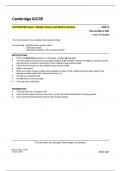Summary
Summary Business Intelligence (BI) & Data Management (DM) - all 4 papers for Information Management master exam
- Course
- Institution
Summary of all papers for the exam Business Intelligence (BI) & Data Management (DM): - ‘Database systems: design, implementation, and management’ (8 edition), P. Rob and C. Coronell. - ‘Data Warehouse Design: Modern Principles and Methodologies’ / Golfarelli & Rizzi / Chapter 1. - Pedersen...
[Show more]




